Abstract
Due to the ongoing growth of microsystems' complexity, there is an urgent need for automatic optimization. In order to include it seamlessly in the customary design process, the algorithms have to be fast and robust. Calculations of the quality function call for at least one FEM-, netlist based or behavioral simulation. Thus the optimization process is a very time consuming task. This paper presents a methodology for enhancing the convergence characteristics of heuristic search methodologies. The concept is to combine direct optimization strategies with interpolation methods in such a way that a mathematical model of the quality function is successively constructed in parallel to an optimization run. Once this model has is meaningful enough, its evaluation can substitute time consuming simulation runs.
Similar content being viewed by others
References
Anton, M., Systematischer Einsatz von Approximations-und Syntheseverfahren für die Modellbildung in der Mikrosystemtechnik. Dissertation, Universität Bremen, 1999.
Peters, D. and Laur, R., “Microsystem model evaluation via optimization strategies,” in Proceedings of the fourth International Conference on Modeling and Simulation of Microsystems, March 2001.
Meienguet, J., “An intrinsic approach to multivariate spline interpolation at arbitrary points” 1, pp. 163–190, 1978.
Schwetlick, H. and Kretzschmar, H., Numerische Verfahren für Naturwissenschaftler und Ingenieure-Eine computerorientierte Einführung. Fachbuchverlag GmbH Leipzig, 1991.
Powell, M. J. D., “A review of methods for multivariable interpolation at scattered data points” 1, pp. 283–309, 1997.
Iske, A. and Sonar, T., “On the structure of function spaces in optimal recovery of point functionals for eno-schemes by radial basis function.” Numerische Mathematik 74(2), pp. 177–202, 1996.
Ishikawa, T. and Matsunami, M., “An optimization method based on radial basis function.” IEEE Transactions on Magnetics 33, pp. 1868–1871, March 1997.
Parodat, S., “MARABU-Ein Werkzeug zur approximation nichtlinearer Kennlinien mit radialen basisfunktionen,” 6, Workshop-Methoden und Werkzeuge zum Entwurf von Mirkosystemen 1, pp. 49–58, December 1997.
Alotto, P., Caiti, A., Molinari, G. and Repetto, M., “A multiquadrics-based algorithm for the acceleration of simulated annealing optimization procedures.” IEEE Transactions on Magnetics 32, pp. 1198–1201, May 1996.
Rehfuss, S., Peters, D. and Laur, R., “Integration of a permeable layer into micro coil modelling and first steps of automatic optimization,” in Proceedings of the third International Conference on Modeling and Simulation of Microsystems, San Diego, March 2000.
Pahner, U. and Hameyer, K., “Adaptive coupling of differential evolution and multiquadrics approximation for the tuning of the optimization process.” IEEE Transactions on Magnetics 36, pp. 1047–1051, July 2000.
Box, M. J., “A new method of constrained optimization and a comparison with other methods.” Computer Journal 8, pp. 42–52, 1965.
Prasad, K. B. S. and Saibabu, K. B. S., “A probabilistic approach to modify the complex method.” Computers & Chemical Engineering 6(2), pp. 97–99, 1982.
Manetsch, T. J., “Toward efficient global optimization in large dynamic systems-The adaptive complex method.” IEEE Transactions on Systems, Man, and Cybernetics 20, pp. 257–261, January/February 1990.
Guin, J. A., “Modification of the complex method of constrained optimization.” Computer Journal 10, pp. 416–417, 1968.
Nelder, J. A. and Mead, R., “A simplex method for function minimization.” Computer Journal 7, pp. 308–313, 1965.
Schwefel, H. P., Evolution and Optimum Seeking, John Wiley & Sons, 1995.
Peters, D., Bolte, H., Marschner, C., Rehfuss, S. and Laur, R., “Theoretical basis for including small as well as large deflections of quadratic membrane structures in one behavioral model,” in Proceedings of SPIE 4228, pp. 44–54, November 2000.
Author information
Authors and Affiliations
Corresponding author
Rights and permissions
About this article
Cite this article
Peters, D., Bolte, H., Marschner, C. et al. Enhanced Optimization Algorithms for the Development of Microsystems. Analog Integrated Circuits and Signal Processing 32, 47–54 (2002). https://doi.org/10.1023/A:1016071624422
Issue Date:
DOI: https://doi.org/10.1023/A:1016071624422




